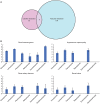Updated Insights on Cardiac and Vascular Risks of Proton Pump Inhibitors: A Real-World Pharmacovigilance Study
- PMID: 35282344
- PMCID: PMC8913586
- DOI: 10.3389/fcvm.2022.767987
Updated Insights on Cardiac and Vascular Risks of Proton Pump Inhibitors: A Real-World Pharmacovigilance Study
Abstract
Background: Proton pump inhibitors (PPIs) are among the most widely prescribed medications in clinical practice. However, there are also concerns about the potential risks of long-term PPI use. The present study aimed to examine the safety of PPIs and summarize their potential cardiac and vascular risks in a real-world setting.
Methods: This pharmacovigilance study extracted records between January 2015 and December 2019 from the FDA Adverse Event Reporting System (FAERS) database. The association of seven PPI medications with cardiac and vascular events (CVEs) were evaluated. Two established pharmacovigilance methods, reporting odds ratio (ROR) and information components (IC) based statistical shrinkage, were used to measure disproportionality.
Results: In total 62,140 CVE records associated with PPI use were investigated. Women showed a higher proportion (54.37%) of PPI-associated CVEs. The median time from PPI initiation to CVE onset was 97 [interquartile range (IQR): 8-491] days, with the shortest median time of 42 days (IQR: 2-277 days) for esomeprazole, and the longest time of 389 days (IQR: 0-525 days) for dexlansoprazole. Although PPIs were not associated with elevated CVE risks compared those of the whole database (IC025/ROR025 = -0.39/0.74), various signals emerged. Despite some similarities exist between the PPIs, their cardiac and vascular safety profiles varied significantly. Pantoprazole showed the broadest spectrum of signals, from thrombotic thrombocytopenic purpura (IC025/ROR025 = 0.01/1.08) to renal haemangioma (IC025/ROR025 = 3.14/9.58). Esomeprazole showed the second-broadest spectrum of toxicities, ranging from duodenal ulcer hemorrhage (IC025/ROR025 = 0.07/1.28) to hypertensive nephropathy (IC025/ROR025 = 4.09/18.72). Vascular signals were more dominant than cardiac signals, suggesting that vascular function was more heavily affected. Hypertensive nephropathy, renal haemangioma, renal artery stenosis, and renal infarct had strong signals across most PPI regimens and merited further attention.
Conclusions: PPIs may inflict various CVEs, particularly those involving the vascular system, on the users. Given the wide range of onset times and different toxicity profiles for various PPI medications, they should be prescribed with caution.
Keywords: FAERS database; cardiac; disproportionality analysis; proton pump inhibitors; vascular.
Copyright © 2022 Zhai, Ye, Hu, Xu, Guo, Lin, Zhou, Guo, Cao and He.
Conflict of interest statement
The authors declare that the research was conducted in the absence of any commercial or financial relationships that could be construed as a potential conflict of interest.
Figures



Similar articles
-
Cardiovascular toxicity associated with angiogenesis inhibitors: A comprehensive pharmacovigilance analysis based on the FDA Adverse Event Reporting System database from 2014 to 2021.Front Cardiovasc Med. 2022 Oct 13;9:988013. doi: 10.3389/fcvm.2022.988013. eCollection 2022. Front Cardiovasc Med. 2022. PMID: 36312283 Free PMC article.
-
Data mining and analysis for emicizumab adverse event signals based on the Food and Drug Administration Adverse Event Reporting System database.Int J Clin Pharm. 2023 Jun;45(3):622-629. doi: 10.1007/s11096-022-01514-4. Epub 2023 Feb 27. Int J Clin Pharm. 2023. PMID: 36848023
-
Cardiovascular toxicity profiles of immune checkpoint inhibitors with or without angiogenesis inhibitors: a real-world pharmacovigilance analysis based on the FAERS database from 2014 to 2022.Front Immunol. 2023 May 24;14:1127128. doi: 10.3389/fimmu.2023.1127128. eCollection 2023. Front Immunol. 2023. PMID: 37292205 Free PMC article.
-
Immediate-Type Hypersensitivity Cross-Reactions to Proton Pump Inhibitors: A Descriptive Study of Data from the French National Pharmacovigilance Database.Int Arch Allergy Immunol. 2019;178(2):159-166. doi: 10.1159/000493581. Epub 2018 Nov 28. Int Arch Allergy Immunol. 2019. PMID: 30485850
-
Myopathy including polymyositis: a likely class adverse effect of proton pump inhibitors?Eur J Clin Pharmacol. 2006 Jun;62(6):473-9. doi: 10.1007/s00228-006-0131-1. Epub 2006 Apr 22. Eur J Clin Pharmacol. 2006. PMID: 16758264 Review.
Cited by
-
Osseous implications of proton pump inhibitor therapy: An umbrella review.Bone Rep. 2024 Feb 1;20:101741. doi: 10.1016/j.bonr.2024.101741. eCollection 2024 Mar. Bone Rep. 2024. PMID: 38348455 Free PMC article. Review.
-
Efficacy and safety of concomitant use of proton pump inhibitors with aspirin-clopidogrel dual antiplatelet therapy in coronary heart disease: A systematic review and meta-analysis.Front Pharmacol. 2023 Jan 10;13:1021584. doi: 10.3389/fphar.2022.1021584. eCollection 2022. Front Pharmacol. 2023. PMID: 36703730 Free PMC article.
-
Inhibitors of gastric acid secretion increase oxidative stress and matrix metalloproteinase-2 activity leading to vascular remodeling.Mol Cell Biochem. 2024 Nov;479(11):3141-3152. doi: 10.1007/s11010-023-04921-x. Epub 2024 Feb 1. Mol Cell Biochem. 2024. PMID: 38302836
-
The Safety of Long-Term Proton Pump Inhibitor Use on Cardiovascular Health: A Meta-Analysis.J Clin Med. 2022 Jul 15;11(14):4096. doi: 10.3390/jcm11144096. J Clin Med. 2022. PMID: 35887860 Free PMC article. Review.
-
Postmarket safety profile of suicide/self-injury for GLP-1 receptor agonist: a real-world pharmacovigilance analysis.Eur Psychiatry. 2023 Nov 30;66(1):e99. doi: 10.1192/j.eurpsy.2023.2474. Eur Psychiatry. 2023. PMID: 38031404 Free PMC article.
References
LinkOut - more resources
Full Text Sources

